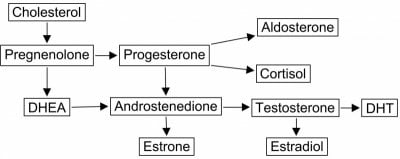Nelson Vergel
Founder, ExcelMale.com

Response of serum testosterone and its precursor steroids, SHBG and CBG to anabolic steroid and testosterone self-administration in man.
Ruokonen A, et al. J Steroid Biochem. 1985.
Abstract
The influence of high doses of testosterone and anabolic steroids on testicular endocrine function and on circulating steroid binding proteins, sex hormone binding globulin (SHBG) and cortisol binding globulin (CBG), were investigated in power athletes for 26 weeks of steroid self-administration and for the following 16 weeks after drug withdrawal. Serum testosterone and androstenedione concentrations increased (P less than 0.05) but pregnenolone, 17-hydroxypregnenolone, dehydroepiandrosterone, 5-androstene-3 beta, 17 beta-diol, progesterone and 17-hydroxyprogesterone concentrations strongly decreased (P less than 0.001) during steroid administration. Serum pregnenolone, 17-hydroxypregnenolone and dehydroepiandrosterone sulphate concentrations followed the changes of the corresponding unconjugated steroids but 5-androstene-3 beta, 17 beta-diol and testosterone sulphate concentrations remained unchanged during the follow-up time. During drug administration SHBG concentrations decreased by about 80 to 90% and remained low even for the 16 weeks following steroid withdrawal. Steroid administration had no influence on serum CBG concentrations. In conclusion, self-administration of testosterone and anabolic steroids soon led to impairment of testicular endocrine function which was characterized by low concentrations of testosterone precursors, high ratios of testosterone to its precursor steroids and low SHBG concentrations. Decreased concentrations of SHBG and testicular steroids were still partly evident during the 16 weeks after drug withdrawal. The depressed circulating levels of dehydroepiandrosterone and its sulphate may indicate that the androgenic-anabolic steroids also suppress adrenal androgen production.
Attachments
Last edited:
















